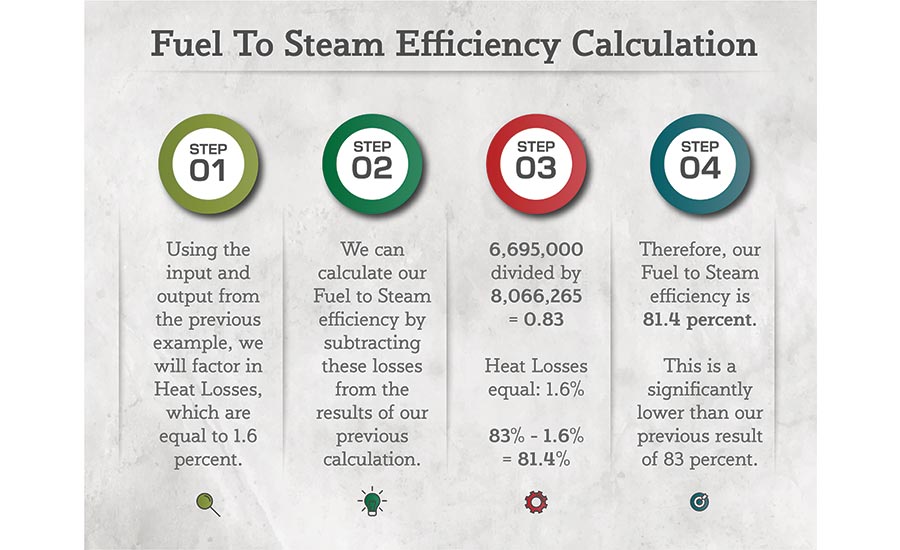Boiler efficiency is undoubtedly the most important and widely used term when the subject of purchasing a new steam system arises. Unfortunately, the goal of the industry, at times, seems to be to make the process of understanding efficiency as difficult as possible. This occurs through an array of terms and equations provided in the language of seasoned engineers that don’t make the slightest bit of sense to first time or casual users. While there are numerous factors that can contribute to a boiler’s efficiency, having a perfect understanding isn’t critical. However, general knowledge of terminology and principles can go a long way in helping a buyer come to an assured and confident decision.
This article will break down the subject of boiler efficiency, define how it relates to making a new purchase, and provide answers to important questions buyers should ask potential suppliers.
Why Does Efficiency Matter?
Efficiency’s importance comes down to fuel bills. In the average industrial scenario, the final cost of a new steam system, including delivery and installation, pales in comparison to the amount one will spend in fuel over the lifetime of the boiler. It’s not uncommon to spend two to three times this amount in fuel in the first year alone. This represents an annual expense that will be incurred as long as the boiler is in operation.
Efficiency is so important because it directly impacts a facility’s yearly costs, and as little as 1% can equal tens of thousands of dollars. While the natural inclination may be to accept a lower cost upfront, this decision could result in hundreds of thousands of additional dollars spent on fuel over the years to come.
 Figure 2. A simplified boiler efficiency calculation, steps 1 to 4.
Figure 2. A simplified boiler efficiency calculation, steps 1 to 4.
What Is Efficiency?
Boiler efficiency represents the difference between a unit’s energy input and output, expressed as a percentage, or how much steam a boiler is able to produce relative to its fuel usage. However, this term is often used as a general blanket statement to summarize any and all of the factors that may be contributing. When this term is being used, its important to understand what is or is not being represented, something a potential supplier should be able to provide a buyer with.
For example, to get a quick breakdown of your efficiency rating, simply take a boiler’s output and divide by its input. This will provide a starting point for inquiries, but keep in mind this doesn’t take into consideration all the factors that could be affecting efficiency and only provides a general reflection.
 Figure 3. A fuel to steam efficiency calculation, steps 1 to 4.
Figure 3. A fuel to steam efficiency calculation, steps 1 to 4. Oftentimes, a supplier may provide this number as its final efficiency rating, so be sure to ask. Further, energy inputs and outputs should be freely listed on a boiler company’s website in its technical documentation so that a buyer can run the numbers himself. If these numbers are difficult or impossible to find, it may raise some questions about their reputability.
Terminology and Calculations
There are several areas of consideration that contribute to determining a boiler’s true efficiency. Here are some of the terms that may come up when discussing this subject.
Thermal Efficiency — When used in reference to steam boilers, this refers to the effectiveness of a heat exchanger, or, more directly, how well heat is being transferred from the fuel supply into usable steam. However, the focus is on the heat exchanger, not the boiler, even though this term is often mistakenly applied to boilers. Thermal efficiency is a factor in overall efficiency, but not the be all and end all it is commonly presented as. Thus, it is not a very useful term when comparing one boiler to another.
Combustion Efficiency — This is a measure of how well a boiler is burning fuel. It specifically refers to the total heat released during combustion, minus heat that is lost in the combustion process. Under ideal circumstances, a boiler’s combustion will result in low levels of unburned fuel and excess air. However, in a real-world application, combustion conditions are never perfect and will always require some measure of excess air to burn completely. Finding this balance becomes crucial. Not enough air will result in unused fuel and the production of soot and carbon monoxide, whereas too much air will result in heat losses. Both scenarios have a negative impact on savings.
Taking this measurement is easily done through a quick analysis of combustion air by means of a combustion analyzer and is a good way to compare performance between boilers.
Heat Losses — While not technically a measure of efficiency, there are three general types of heat loss that effect a boiler and heavily contribute to its overall efficiency in the form of wasted energy.
- Convection losses refer to heat lost from airflow surrounding the boiler.
- Radiation losses refer to losses from heat that radiates from the boiler shell.
- Stack losses refer to heat lost by exhaust gases that exit the boiler stack, having never transferred the heat into a feed water.
When entering a boiler room, is it immediately noticeable how hot the room is? Is there a fear of getting too close to the boiler because one might burn himself? This is a sure sign a boiler is experiencing high heat loss.
Fuel to Steam Efficiency — This is the best possible measurement of efficiency. It considers the final amount of energy that is being converted into steam, taking into consideration factors that contribute to a boiler’s overall efficiency. When a potential supplier begins discussing products, this is what should be presented to potential customers.
Beware of False Claims — There’s a great deal to cover when it comes to efficiency, and there are more factors to take into consideration when determining true boiler efficiency, such as feedwater temperature, steam pressure, or blowdown and firing rates. So, why doesn’t every manufacturer provide these numbers? Unfortunately, not everyone is in the habit of practicing transparency when it comes to their business numbers. There are several industry tricks that can be used to artificially boost efficiency numbers, and an end user doesn’t want to find out too late that he’s losing money.
The best way to avoid this situation is to ask any potential supplier to provide a boiler’s real-world efficiency rating. Different manufacturers may call this by different names, but a potential buyer should be getting a realistic efficiency rating based on the conditions of the facility in question.
Don’t settle for a manufacturer providing a hypothetical rating based on what may be deemed ‘ideal conditions.’ The easiest and most common trick to boost efficiency ratings is to run the boiler under perfect conditions with ideal water temperature and perfect fuel combustion without any heat losses whatsoever.
These conditions seldom exist in the real world, so why would they exist in a boiler room? Make sure the number being provided is realistic to a buyer and his needs, not someone else’s idea of perfection. What temperature will the project’s feedwater be? What pressure will that specific unit be operating at?
There’s an old saying about comparing apples to apples and how it relates to drawing an even comparison. Comparing a real-world rating with an ‘ideal’ one isn’t a similar assessment. Getting this information from multiple suppliers allows them to compare apples to apples, as it were, and make an accurate decision. Any supplier that is unable or unwilling to provide this information may be trying to hide something.
This article has only scratched surface when it comes to breaking down boiler efficiency; however, a buyer doesn’t need an encyclopedic knowledge in order to make an informed decision. By following these basic steps and asking a few questions of any sales personnel, a potential buyer will be well on his way to making an informed decision about any new steam system.




